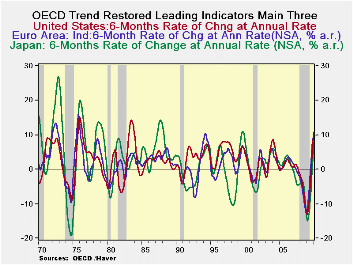 Global| Apr 12 2010
Global| Apr 12 2010OECD LEIs Show Strongest Synchronized Revival Since 1975 Expansion
Summary
History tells us that gains this strong do not continue to accelerate like this for very long. Already the sequential growth rates are showing that the pace of growth is beginning to ebb even though the 12-month rates continue to [...]

History tells us that gains this strong do not continue to accelerate like this for very long. Already the sequential growth rates are showing that the pace of growth is beginning to ebb even though the 12-month rates continue to accelerate. Despite that, the six- month growth rates, the horizon on which the OECD prefers to evaluate its indices, shows a slow down from the previous 6 months but still posts strong rates of expansion. The whole of the OECD area is still advancing at a rate of 8.6% over six months, the e-Zone is up at a 6.6% pace and the US is up at a 10.5% pace. Japan alone is still accelerating, to a pace of 8.6% over six months.
But economic recovery is not simply achieved by getting out of the woods with a strong LEI reading. As we have seen, Europe is dogged by debt problems from Greece to Portugal to Spain. The UK, in the midst of elections, has posted some very erratic economic figures including a recent spike in its PPI. Today Italy posted a sideways IP result with output remaining flat month-to-month. By itself that does not sound so bad, but Italy has a long way to go to restore output to its past cycle peak level. So a month of no progress is not a good result.
The OECD data tell us, however, that results are improving across the OECD area and that conditions in Japan are accelerating. For the time being it is still good news but it is still not good enough given all the post-cycle risks that continue to lurk and to chase after the outlook.
| OECD Trend-restored leading Indicators | ||||
|---|---|---|---|---|
| Growth progression-SAAR | ||||
| 3Mos | 6Mos | 12mos | Yr-Ago | |
| OECD | 6.5% | 8.6% | 10.1% | -11.7% |
| OECD7 | 6.7% | 8.9% | 10.2% | -12.9% |
| OECD.Ezone | 3.5% | 6.6% | 9.8% | -12.1% |
| OECD.Japan | 7.0% | 8.6% | 7.6% | -14.6% |
| OECD US | 9.1% | 10.5% | 10.9% | -13.1% |
| Six month readings at 6-Mo Intervals: | ||||
| Recent six | 6Mo Ago | 12Mo Ago | 18MO Ago | |
| OECD | 8.6% | 11.6% | -14.1% | -9.2% |
| OECD7 | 8.9% | 11.6% | -16.3% | -9.4% |
| OECD.Eur | 6.6% | 13.0% | -12.4% | -11.8% |
| OECD.Japan | 8.6% | 6.6% | -21.1% | -7.6% |
| OECD US | 10.5% | 11.2% | -17.6% | -8.3% |
| Slowdowns indicated by BOLD RED | ||||
Robert Brusca
AuthorMore in Author Profile »Robert A. Brusca is Chief Economist of Fact and Opinion Economics, a consulting firm he founded in Manhattan. He has been an economist on Wall Street for over 25 years. He has visited central banking and large institutional clients in over 30 countries in his career as an economist. Mr. Brusca was a Divisional Research Chief at the Federal Reserve Bank of NY (Chief of the International Financial markets Division), a Fed Watcher at Irving Trust and Chief Economist at Nikko Securities International. He is widely quoted and appears in various media. Mr. Brusca holds an MA and Ph.D. in economics from Michigan State University and a BA in Economics from the University of Michigan. His research pursues his strong interests in non aligned policy economics as well as international economics. FAO Economics’ research targets investors to assist them in making better investment decisions in stocks, bonds and in a variety of international assets. The company does not manage money and has no conflicts in giving economic advice.






